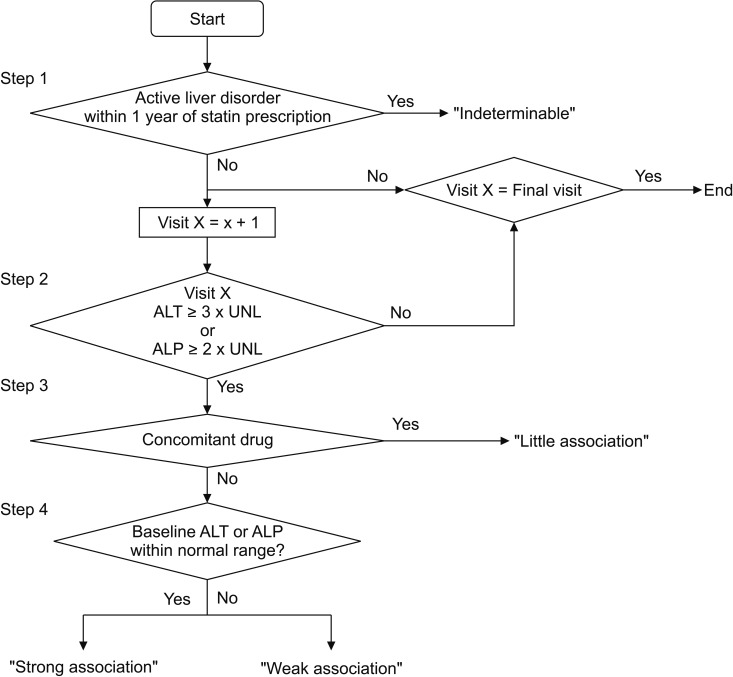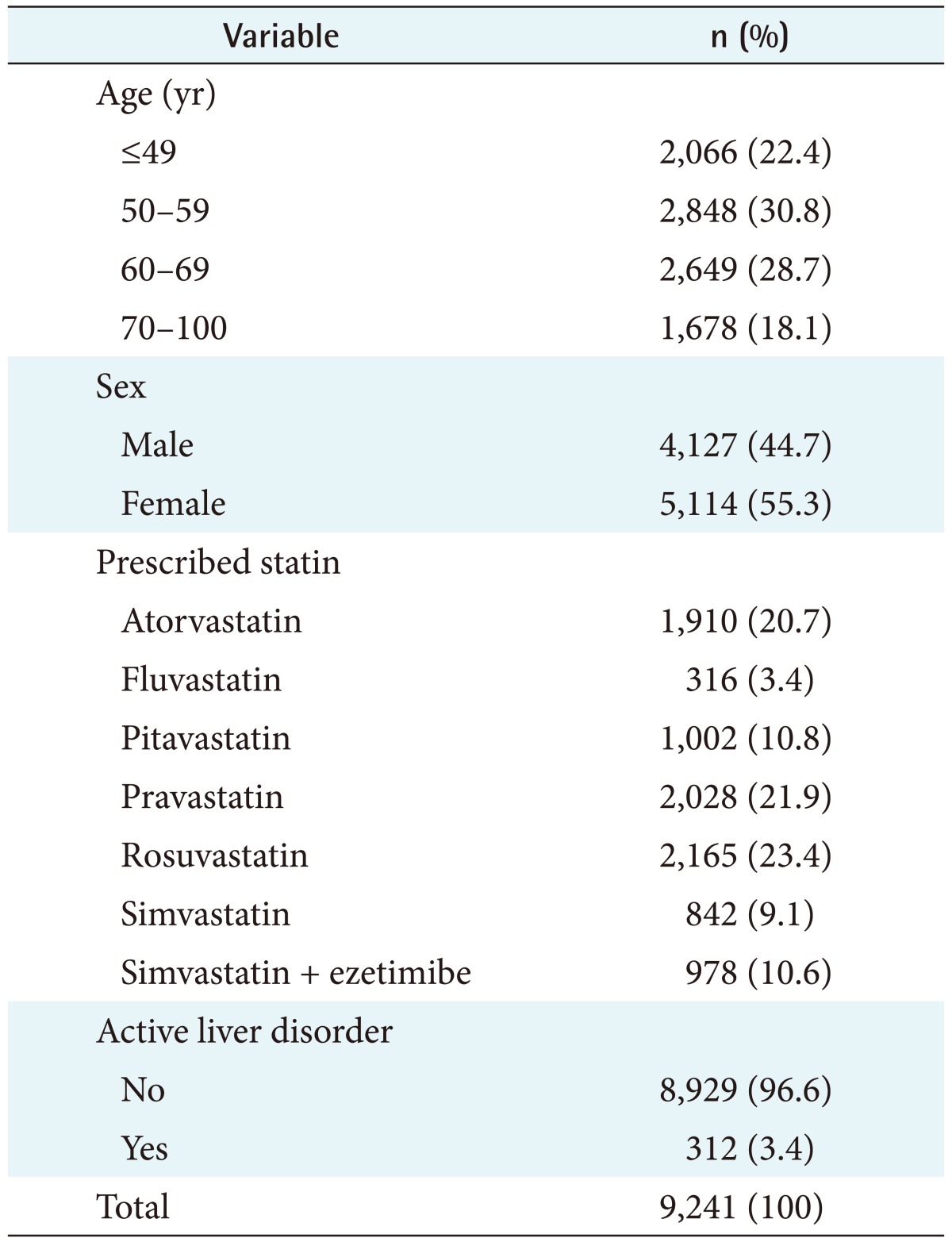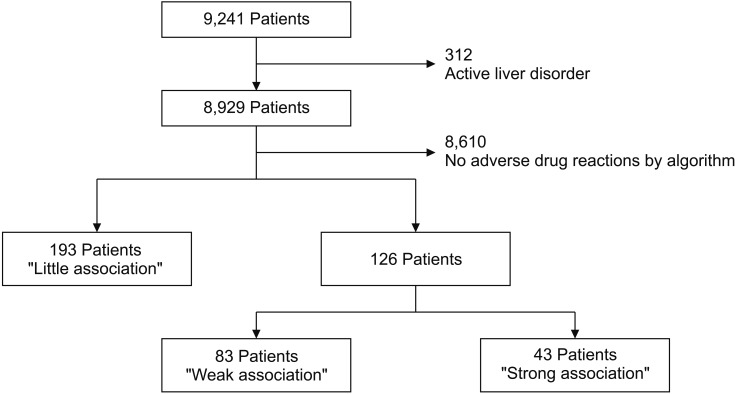1. Shepherd G, Mohorn P, Yacoub K, May DW. Adverse drug reaction deaths reported in United States vital statistics, 1999-2006. Ann Pharmacother. 2012; 46(2):169–175. PMID:
22253191.

2. Brown JS, Kulldorff M, Chan KA, Davis RL, Graham D, Pettus PT, et al. Early detection of adverse drug events within population-based health networks: application of sequential testing methods. Pharmacoepidemiol Drug Saf. 2007; 16(12):1275–1284. PMID:
17955500.

3. Park IW, Sheen SS, Yoon D, Lee SH, Shin GT, Kim H, et al. Onset time of hyperkalaemia after angiotensin receptor blocker initiation: when should we start serum potassium monitoring? J Clin Pharm Ther. 2014; 39(1):61–68. PMID:
24262001.

4. Jha AK, Kuperman GJ, Teich JM, Leape L, Shea B, Rittenberg E, et al. Identifying adverse drug events: development of a computer-based monitor and comparison with chart review and stimulated voluntary report. J Am Med Inform Assoc. 1998; 5(3):305–314. PMID:
9609500.

5. Haerian K, Varn D, Vaidya S, Ena L, Chase HS, Friedman C. Detection of pharmacovigilance-related adverse events using electronic health records and automated methods. Clin Pharmacol Ther. 2012; 92(2):228–234. PMID:
22713699.

6. Hannan TJ. Detecting adverse drug reactions to improve patient outcomes. Int J Med Inform. 1999; 55(1):61–64. PMID:
10471241.

7. Grundy SM. HMG-CoA reductase inhibitors for treatment of hypercholesterolemia. N Engl J Med. 1988; 319(1):24–33. PMID:
3288867.

8. Kim HS, Kim H, Lee H, Park B, Park S, Lee SH, et al. Analysis and comparison of statin prescription patterns and outcomes according to clinical department. J Clin Pharm Ther. 2016; 41(1):70–77. PMID:
26791968.

9. Kim HS, Lee H, Park B, Park S, Kim H, Lee SH, et al. Comparative analysis of the efficacy of low- and moderate-intensity statins in Korea. Int J Clin Pharmacol Ther. 2016; 54(11):864–871. PMID:
27487366.
10. Stone NJ, Robinson JG, Lichtenstein AH, Bairey Merz CN, Blum CB, Eckel RH, et al. 2013 ACC/AHA guideline on the treatment of blood cholesterol to reduce atherosclerotic cardiovascular risk in adults: a report of the American College of Cardiology/American Heart Association Task Force on Practice Guidelines. Circulation. 2014; 129(25 Suppl 2):S1–S45. PMID:
24222016.
11. Kim HS, Lee SH, Kim H, Lee SH, Cho JH, Lee H, et al. Statin-related aminotransferase elevation according to baseline aminotransferases level in real practice in Korea. J Clin Pharm Ther. 2016; 41(3):266–272. PMID:
27015878.

12. Benichou C. Criteria of drug-induced liver disorders: report of an international consensus meeting. J Hepatol. 1990; 11(2):272–276. PMID:
2254635.
13. Bellosta S, Paoletti R, Corsini A. Safety of statins: focus on clinical pharmacokinetics and drug interactions. Circulation. 2004; 109(23 Suppl 1):III50–III57. PMID:
15198967.
14. Tantikul C, Dhana N, Jongjarearnprasert K, Visitsunthorn N, Vichyanond P, Jirapongsananuruk O. The utility of the World Health Organization-The Uppsala Monitoring Centre (WHO-UMC) system for the assessment of adverse drug reactions in hospitalized children. Asian Pac J Allergy Immunol. 2008; 26(2-3):77–82. PMID:
19054924.
15. Knopp RH. Drug treatment of lipid disorders. N Engl J Med. 1999; 341(7):498–511. PMID:
10441607.

16. Bhardwaj SS, Chalasani N. Lipid-lowering agents that cause drug-induced hepatotoxicity. Clin Liver Dis. 2007; 11(3):597–613. PMID:
17723922.

17. Russo MW, Hoofnagle JH, Gu J, Fontana RJ, Barnhart H, Kleiner DE, Chalasani N, Bonkovsky HL. Spectrum of statin hepatotoxicity: experience of the drug-induced liver injury network. Hepatology. 2014; 60(2):679–686. PMID:
24700436.

18. Farmer JA, Torre-Amione G. Comparative tolerability of the HMG-CoA reductase inhibitors. Drug Saf. 2000; 23(3):197–213. PMID:
11005703.

19. Tolman KG. Defining patient risks from expanded preventive therapies. Am J Cardiol. 2000; 85(12A):15E–19E.

20. Sniderman AD. Is there value in liver function test and creatine phosphokinase monitoring with statin use? Am J Cardiol. 2004; 94(9A):30F–34F. PMID:
15219504.

21. Reuben A, Koch DG, Lee WM. Acute Liver Failure Study Group. Drug-induced acute liver failure: results of a U.S. multicenter, prospective study. Hepatology. 2010; 52(6):2065–2076. PMID:
20949552.

22. Russo MW, Scobey M, Bonkovsky HL. Drug-induced liver injury associated with statins. Semin Liver Dis. 2009; 29(4):412–422. PMID:
19826975.

23. Tavassoli N, Duchayne E, Sadaba B, Desboeuf K, Sommet A, Lapeyre-Mestre M, et al. Detection and incidence of drug-induced agranulocytosis in hospital: a prospective analysis from laboratory signals. Eur J Clin Pharmacol. 2007; 63(3):221–228. PMID:
17225990.

24. Bagheri H, Michel F, Lapeyre-Mestre M, Lagier E, Cambus JP, Valdiguie P, et al. Detection and incidence of drug-induced liver injuries in hospital: a prospective analysis from laboratory signals. Br J Clin Pharmacol. 2000; 50(5):479–484. PMID:
11069443.

25. Robb MA, Racoosin JA, Sherman RE, Gross TP, Ball R, Reichman ME, et al. The US Food and Drug Administration's Sentinel Initiative: expanding the horizons of medical product safety. Pharmacoepidemiol Drug Saf. 2012; 21(Suppl 1):9–11. PMID:
22262587.

26. Yoon D, Park MY, Choi NK, Park BJ, Kim JH, Park RW. Detection of adverse drug reaction signals using an electronic health records database: Comparison of the Laboratory Extreme Abnormality Ratio (CLEAR) algorithm. Clin Pharmacol Ther. 2012; 91(3):467–474. PMID:
22237257.

27. Klintmalm GB, Iwatsuki S, Starzl TE. Cyclosporin A hepatotoxicity in 66 renal allograft recipients. Transplantation. 1981; 32(6):488–489. PMID:
7041349.

28. Wagoner LE, Olsen SL, Bristow MR, O'Connell JB, Taylor DO, Lappe DL, et al. Cyclophosphamide as an alternative to azathioprine in cardiac transplant recipients with suspected azathioprine-induced hepatotoxicity. Transplantation. 1993; 56(6):1415–1418. PMID:
8279012.

29. Sai K, Hanatani T, Azuma Y, Segawa K, Tohkin M, Omatsu H, et al. Development of a detection algorithm for statin-induced myopathy using electronic medical records. J Clin Pharm Ther. 2013; 38(3):230–235. PMID:
23530940.

30. Warrer P, Hansen EH, Juhl-Jensen L, Aagaard L. Using text-mining techniques in electronic patient records to identify ADRs from medicine use. Br J Clin Pharmacol. 2012; 73(5):674–684. PMID:
22122057.






 PDF
PDF ePub
ePub Citation
Citation Print
Print







 XML Download
XML Download